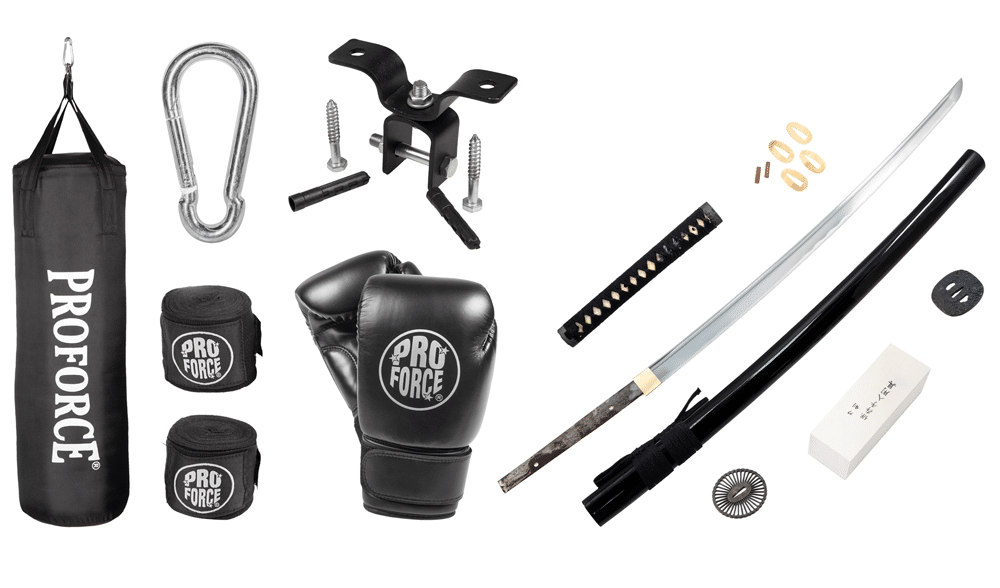Katanas & Samurai Swords
Each samurai sword has its own advantage. Some are good for starting a collection while others are best as training aids or for use during form demonstrations. You can make the selection process as easy as possible for yourself by focusing on construction and material quality, practical concerns, and appearance. Here are a few things to keep in mind when you buy samurai swords online from our Fit2Death.Com Catalog.
Identifying Quality
Examine the blade first when you’re choosing a sword online. The material should be a high-quality, lightweight alloy, such as aluminum or carbon steel. Look for sturdy construction in the handle and guard. Durable handle wrap materials are always nice, but you can also make your own customized wrap after you receive the sword. Finally, look for finished or lacquered wood scabbards to maintain a professional appearance while protecting the blade.
Completing Your Set
How many samurai swords do you need? Throughout most of the samurai period, the warrior class carried two swords. However, they typically only fought with the longer sword: The smaller was mostly regarded as a ceremonial sidearm. Therefore, you should be able to progress with many fighting styles by purchasing a full-size katana option like the ProForce® Deluxe Solid Daito.
There’s an exception to every rule. One of the most famous swordsmen in history, Miyamoto Musashi, was known for using a one-handed grip that allowed him to wield two swords at once. If you aspire to perfect the skills of his Niten Ichiryu school or if you want to wear historically accurate samurai gear, you need both a long and a short sword.
Choosing a Size
The standard contemporary katana size is around 40 inches. However, some schools require a specific length or combination of lengths due to the practical applications of the forms, such as fighting indoors or disarming aggressors. The most common sizes include:
- Daito: 40 inches
- Shoto: 36 inches
- Wakizashi: 29 inches
- Tanto: 8 1/2 inches
These sizes refer to the total length of the sword, measured as a straight line from end to end. The length of the blade itself is sometimes listed as well. The blade of a typical 40-inch katana is usually between 27 and 29 inches.
While you’re looking through the Fit2Death.Com online catalog, you might come across some items with two numbers for the same sword. One example would be the ProForce Daito mentioned earlier: The large size is listed as 29 inches by 40 inches. In this case, the first number refers to the blade length and the second is the total from the tip to the butt end.
Training Equipment vs. Demonstration Pieces
Learning a samurai fighting style is usually accomplished through practice with wooden or bamboo swords called bokken and shinai, respectively. This traditional training equipment is safer than real metal swords, making them ideal for paired sparring sessions or routine form practice. Foam weapons are also a popular modern option. In contrast, metal swords are usually displayed in the training area, only taken out to demonstrate mastery of solo forms.
Wooden, bamboo, and foam equipment are enough for most practice situations. However, some schools often use metal swords during training. One prominent example is iaido, a discipline focused on unsheathing the sword quickly and delivering precise strikes. Experience with the balance of a metal sword is key to mastery of this technique, so most practitioners of iaido own an iai-to for training purposes.
The Importance of Aesthetics
It’s perfectly acceptable to let the look of a sword influence your decision. Samurai-style fighting is an ancient discipline. Its tools are instruments of war and destruction, but they also represent an elite social class of fighters. That means the Japanese sword is a symbol of strength, beauty, and control. Don’t shy away from requiring a certain level of refinement and style. Consider the impact a beautiful sword makes during a demonstration. Look for details indicative of fine craftsmanship, such as single-piece wood scabbards, engraved blades, and meticulously polished edge patterns. To protect your sword, search for a cover, such as the ProForce® Super Deluxe Sword Case.
Making a Choice
People acquire swords for many reasons. Some are collectors who appreciate the power and beauty of these items. Others need specialized equipment for practicing a martial arts style. Choose the right samurai swords for you by focusing on quality first, then considering quantity, size, purpose, and appearance. If you’re not sure where to start, check out the ProForce® Extreme Demo samurai swords to see a full range of options and sizes.


